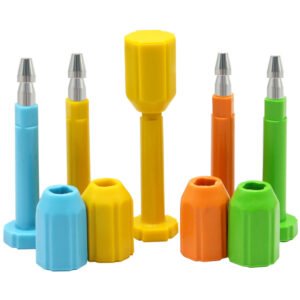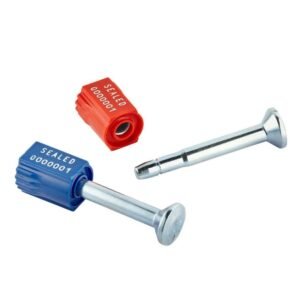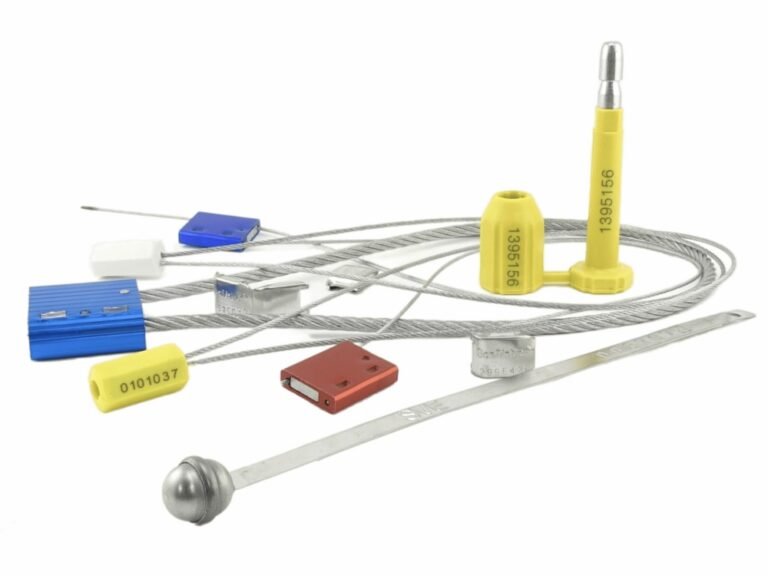Bolt seals are essential for securing cargo and preventing tampering during transit. This guide explores what bolt seals are, how they work, and their importance in global supply chains. Discover the components of bolt seals, their applications, benefits, and key industry standards. Learn how to choose the right bolt seals to protect your business operations effectively.
What Exactly Are Bolt Seals?
Bolt seals are high-security, single-use locking devices primarily designed for securing cargo containers, trucks, and trailers. They consist of a steel bolt (pin) and a separate locking body (bush) that, once engaged, cannot be separated without being physically broken, typically with bolt cutters.
What are their main applications?
You see bolt seals used extensively on:
- Shipping containers (intermodal, sea freight)
- Truck and trailer doors
- Railcar doors
- Bonded warehouses and other high-value storage areas
Why are they considered high-security?
Their robust steel construction and unique, one-time locking mechanism make them highly resistant to physical attack and provide immediate visual indication of tampering. Many are C-TPAT compliant and meet ISO 17712 standards for “H” (High Security) seals.

The Anatomy of a Bolt Seal: Key Components
Understanding the parts of a bolt seal helps appreciate its security effectiveness.
Bolt/Pin
This is a solid steel shaft, often coated with plastic for environmental protection and color-coding. One end is typically pointed for easy insertion, and the other features grooves or a specific profile that engages with the locking mechanism.
Locking Body/Bush
This component houses the locking mechanism. It is usually made of steel and encased in a durable plastic shell, which can be customized with colors, company logos, serial numbers, and barcodes.
Technical Focus
When the pin is inserted into the locking body, internal spring-loaded components, often ball bearings or locking collets, snap into place around the pin’s grooves. This creates a permanent, non-reversible lock. The plastic coating on both parts also plays a role; if tampered with, it will show signs of stress, discoloration, or breakage.

How Do Bolt Seals Provide Security?
Bolt seals offer security through several integrated features:
Barrier Function: Their strong steel construction acts as a physical deterrent, requiring significant force and specific tools (like bolt cutters) to remove.
Tamper Evidence: Any attempt to forcibly remove or bypass the seal will leave clear, undeniable visual evidence. The plastic casing may crack, or the steel components may show distortion.
Anti-Spin Feature: Many high-quality bolt seals incorporate an anti-spin mechanism. This means the pin and body interlock in such a way that they cannot be spun relative to each other. This feature prevents attempts to “spin off” the seal using friction or high-speed rotation.
Unique Identification: Each bolt seal is marked with a unique serial number. This number is crucial for:
- Tracking: Logging the seal number at origin and destination.
- Chain of Custody: Verifying that the original seal is intact upon arrival.
- Preventing Duplication: Making it difficult for unauthorized individuals to replace a seal with an identical, unmarked one. Barcodes can further enhance this, allowing for quick scanning and integration into digital logistics systems.
Meeting Global Standards: ISO 17712 Certification
The International Organization for Standardization (ISO) sets benchmarks for security seals. ISO 17712 is the key standard for mechanical freight container seals.
What does ISO 17712 specify?
This standard classifies seals into three categories: “I” for Indicative, “S” for Security, and “H” for High Security. Bolt seals typically aim for the “H” classification, which requires them to pass stringent tests for tensile strength, shear strength, and impact resistance.
Why is compliance important?
Customs Programs: Many customs authorities worldwide, including the US Customs-Trade Partnership Against Terrorism (C-TPAT), mandate the use of ISO 17712 “H” class seals for international shipments.
Insurance: Some insurers may require compliant seals for coverage of high-value goods.
Interoperability: It ensures a consistent level of security across global supply chains. You can verify a seal’s compliance by checking documentation from the manufacturer or looking for markings on the seal itself.
The Tangible Benefits of Using Bolt Seals
Investing in quality bolt seals offers significant advantages for your business:
- Deters Theft: The visible presence of a robust bolt seal discourages opportunistic thieves.
- Prevents Unauthorized Access: It creates a strong physical barrier against entry.
- Provides Irrefutable Tamper Evidence: If tampering occurs, it’s immediately obvious.
- Supports Regulatory Compliance: Helps meet requirements for programs like C-TPAT.
- Reduces Cargo Loss and Damage: Minimizes financial losses due to theft or contamination.
- Enhances Supply Chain Integrity: Builds trust with customers and partners by demonstrating a commitment to security.
- Cost-Effective Security: The cost of a bolt seal is minimal compared to the potential value of the cargo it protects.
Selecting the Optimal Bolt Seal for Your Needs
Choosing the right bolt seal involves considering several factors:
- Security Requirements:
- High-Value Cargo: Always opt for ISO 17712 “H” certified seals.
- Domestic vs. International: International shipments often have stricter requirements.
- Operational Needs:
- Color-Coding: Use different colors for various routes, cargo types, or destinations for quick visual identification.
- Customization: Company logos, names, and specific numbering sequences enhance security and brand visibility.
- Barcoding: For integration with digital tracking systems, consider seals with 1D or 2D barcodes.
- Supplier Reliability:
- Choose reputable suppliers who can provide genuine, certified seals.
- Inquire about their quality control processes.
- Consider our range of customizable bolt seals for options.
Practical Tip: Always order seals with unique, sequential numbering that you can track. Avoid generic, unnumbered seals as they offer minimal traceability.
Proper Application and Removal Procedures
Correct usage is as important as the seal itself.
How to Apply a Bolt Seal:
- Ensure the container/truck door latches are properly aligned and closed.
- Insert the bolt pin through the latch mechanism.
- Firmly push the locking body onto the protruding end of the pin until it clicks securely into place.
- Give the seal a firm tug to confirm it is properly engaged and cannot be pulled apart.
- Record the seal number, date, time, and location in your log or digital system.

How to Remove a Bolt Seal:
- Verify the seal number against your records before removal.
- Inspect the seal for any signs of tampering. Document any irregularities with photographs if possible.
- Use heavy-duty bolt cutters to cut through the steel pin. Always wear appropriate safety glasses during removal.
- Dispose of the used seal components responsibly, ensuring they cannot be reassembled or misused.
Beyond Security: Bolt Seals in Logistics Management
While their primary function is security, bolt seals contribute to broader logistics efficiency:
- Enhanced Track and Trace: Serialized seals, especially those with barcodes, integrate seamlessly with Warehouse Management Systems (WMS) and Transportation Management Systems (TMS). This provides real-time data points throughout the cargo’s journey.
- Strengthened Chain of Custody: Documenting seal numbers at each transfer point creates an auditable trail, vital for accountability and dispute resolution.
- Data for Optimization: Analyzing seal data (e.g., locations where tampering is frequent) can help identify high-risk routes or handling points, allowing for process improvements or rerouting.
- Improved Inventory Management: Knowing that cargo is securely sealed reduces the need for frequent physical checks, streamlining inventory processes. By leveraging the data associated with bolt seals, businesses can gain valuable insights that extend beyond simple security, contributing to more efficient and transparent operations.
Conclusion
Bolt seals are more than just pieces of metal and plastic; they are crucial components in the architecture of a secure and efficient supply chain. They provide a robust physical barrier, clear tamper evidence, and vital tracking capabilities. Understanding their function and benefits empowers you to enhance the security and integrity of your cargo from origin to destination.
Frequently Asked Questions (FAQ)
Q1: What is the main difference between a bolt seal and a cable seal?
Bolt seals offer higher barrier strength due to their solid steel pin and are typically used for high-security applications like shipping containers. Cable seals offer more flexibility for applications with misaligned locking points or smaller hasps, providing strong tamper evidence but generally less brute-force resistance than a bolt seal.
Q2: Can bolt seals be reused?
A: No, bolt seals are designed for single use only. Once properly locked, they must be cut with bolt cutters for removal. This one-time use feature is essential for their security integrity, as it ensures any opening is evident.
Q3: How strong are ISO 17712 “H” rated bolt seals?
A: ISO 17712 “H” rated bolt seals must withstand specific forces: a minimum of 1000 kg (2205 lbs) of tensile (pull) strength, 340 kg (750 lbs) of shear strength, and a 40.7 kg (90 lbs) impact test. This makes them very resistant to accidental breakage and deliberate attacks without specialized tools.
Q4: Are all bolt seals C-TPAT compliant?
A: Not necessarily. To be C-TPAT compliant, bolt seals must generally meet or exceed the ISO 17712 standard for “H” (High Security) seals. Always verify with your supplier that the specific bolt seals you are purchasing meet these criteria.
Contact Us
For expert advice on selecting the right bolt seals for your specific needs, or to inquire about ProtegoSeal‘s range of customizable, high-security sealing solutions, please get in touch with our team. We are here to help you enhance your cargo security.
- Email: info@protegoseal.com
- Phone: +86 15322882223
- Website: Visit our contact page

